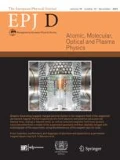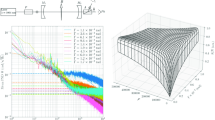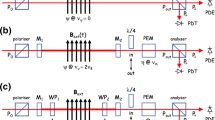Abstract
QED vacuum can be polarized and magnetized by an external electromagnetic field, therefore acting as a birefringent medium. This effect has not yet been measured. In this paper, after having recalled the main facts concerning vacuum magnetic birefringence polarimetry detection method and the related noise sources, we detail our Monte Carlo simulation of a pulsed magnetic field data run. Our Monte Carlo results are optimized to match BMV experiment 2014 data. We show that our Monte Carlo approach can reproduce experimental results giving an important insight into the systematic effects limiting experiment sensitivity.
Graphic abstract













Similar content being viewed by others
Data Availibility Statement
This manuscript has no associated data or the data will not be deposited. [Authors’ comment: Any data can be obtained directly from the corresponding author.]
References
R. Battesti, C. Rizzo, Rep. Prog. Phys. 76, 016401 (2013)
Y.R. Shen, The Principles of Nonlinear Optics (Wiley, Hoboken, 2003)
T. Erber, Nature 190, 25–27 (1961)
R. Battesti, J. Beard, S. Boser, N. Bruyant, D. Budker, S.A. Crooker, E.J. Daw, V.V. Flambaum, T. Inada, I.G. Irastorza, F. Karbstein, D.L. Kim, M.G. Kozlov, Z. Melhem, A. Phipps, P. Pugnat, G. Rikken, C. Rizzo, M. Schott, Y.K. Semertzidis, H.H.J. ten Kate, G. Zavattini, Phys. Rep. 765, 1 (2018)
E. Iacopini, E. Zavattini, Phys. Lett. B 85, 151 (1979)
A. Cadène, P. Berceau, M. Fouché, R. Battesti, C. Rizzo, Eur. Phys. J. D 68, 16 (2014)
X. Fan, S. Kamioka, T. Inada, T. Yamazaki, T. Namba, S. Asai, J. Omachi, K. Yoshioka, M. Kuwata-Gonokami, A. Matsuo, K. Kawaguchi, K. Kindo, H. Nojiri, Eur. Phys. J. D 71, 308 (2017)
JCGM, Evaluation of measurement data—Guide to the expression of uncertainty in measurement (2008)
V.F. Della, A. Ejlli, U. Gastaldi, G. Messineo, E. Milotti, R. Pengo, G. Ruoso, G. Zavattini, Eur. Phys. J. C 76, 24 (2016)
A. Ejlli, V.F. Della, U. Gastaldi, G. Messineo, R. Pengo, G. Ruoso, G. Zavattini, Phys. Rep. 871, 1–74 (2020)
F. Karbstein, Phys. Rev. D 98, 056010 (2018)
B.F. Shen, Z.G. Bu, J.C. Xu, T.J. Xu, L.L. Ji, R.X. Li, Z.Z. Xu, Plas. Phys. Cont. Fus. 60, 044002 (2018)
R.P. Mignani, V. Testa, D.G. Caniulef, R. Taverna, R. Turolla, S. Zane, K. Wu, Mon. Not. R. Astron. Soc. 465, 492–500 (2017)
L.M. Capparelli, A. Damiano, L. Maiani, A.D. Polosa, Eur. Phys. J. C 77, 754 (2017)
G. Aad et al., ATLAS collaboration. Phys. Rev. Lett. 123, 052001 (2019)
A.M. Sirunyan et al., CMS collaboration. Phys. Lett. B 797, 134826 (2019)
R. Battesti, B. Pinto Da Souza, S. Batut, C. Robilliard, G. Bailly, C. Michel, M. Nardone, L. Pinard, O. Portugall, G. Trénec, J.-M. Mackowski, G.L.J.A. Rikken, J. Vigué, C. Rizzo, Eur. Phys. J. D 46, 323 (2008)
M. Born, E. Wolf, Principles of optics (Pergamon Press, 1980), pp. 36–111
V.F. Della, E. Milotti, A. Ejlli, U. Gastaldi, G. Messineo, L. Piemontese, G. Zavattini, R. Pengo, G. Ruoso, Opt. Express 22, 11570–11577 (2014)
F. Bielsa, A. Dupays, M. Fouché, R. Battesti, C. Robilliard, C. Rizzo, Appl. Phys. B 97, 457 (2009)
S. Xiao, B. Li, J. Wang, Appl. Opt. 59, A99–A105 (2020)
B. Jacob, M.N. Vallet, F. Bretenaker, A. Le Floch, M. Oger, Opt. Lett. 20, 671–673 (1995)
Y. Takudo, N. Takeda, J.H. Huang, K. Muroo, M. Yamamoto, Meas. Sci. Technol. 9, 20–23 (1998)
P. Berceau, M. Fouché, R. Battesti, F. Bielsa, J. Mauchain, C. Rizzo, Appl. Phys. B 100, 803–809 (2010)
P. Berceau, M. Fouché, R. Battesti, C. Rizzo, Phys. Rev. A 85, 013837 (2012)
M.T. Hartman, A. Rivère, R. Battesti, C. Rizzo, Rev. Sci. Inst. 88, 123114 (2017)
G. Zavattini, V.F. Della, A. Ejlli, W.-T. Ni, U. Gastaldi, E. Milotti, R. Pengo, G. Ruoso, Eur. Phys. J. C 78, 585 (2018)
M.T. Hartman, R. Battesti, C. Rizzo, IEEE Trans. Inst. Meas. 68, 2268–2273 (2019)
J. Timmer, M. Koenig, Astr. Astrophys. 300, 707 (1995)
Acknowledgements
This research has been partially supported by ANR (Grant No. ANR-14-CE32-0006). We thank all the members of the BMV collaboration. We specially thank M. Hartman and A. Charry and all the authors of [6].
Author information
Authors and Affiliations
Contributions
All the authors were involved in the preparation of the manuscript. All the authors have read and approved the final manuscript.
Corresponding author
Appendix: discussion on the intensity ratio formula
Appendix: discussion on the intensity ratio formula
The formula used in 2014 to determine the ellipticity from the intensities is in our notation
in this “Appendix” we will show that the error performed from the exact expression Eq. 11 is negligible. We recall that we have defined the operator \(\hat{C}\) associated to the cavity transfer function \(H(\nu )\) with a cutoff frequency \(\nu _c\) so that \(\varPsi _{f}(t)=\hat{C}[\varPsi (t)]=\mathscr {F}^{-1}[H(\nu )\mathscr {F}[\varPsi (t)]]\) where \(\mathscr {F}\) is the operator of the Fourier transform.
We consider that the ordinary intensity shows a small modulation around a DC value as \(P_{t}(t)=P_{t}^{\mathrm{DC}}\left( 1+\beta \cos \omega t\right) \) with \(\beta \ll 1\). To simplify we will also consider that the magnetic field is oscillating as \(B(t)=A\cos \omega _{\mathrm{B}}t\); therefore, the ellipticity \(\varPsi (t)\) can be written as
We calculate \(P_{e}(t)\) using Eq. 11 taking the case \(\varPsi (t)\ll \varGamma \) so
injecting our expressions for \(P_{t}(t)\) and \(\varPsi (t)\), we obtain
In order to calculate the ellipticity \(\varPsi ^{2014}(t)\) of 2014, we have to determine the inverse of \(P_{t,f}(t)=\hat{C}\left( P_{t}(t)\right) \)
because \(\beta \ll 1\). We calculate the ratio \(P_{e}(t)/P_{t,f}(t)\), neglecting of terms in \(\beta ^{2}\)
We finally obtain the ellipticity as it was computed in 2014, that is \(\varPsi ^{2014}(t)=\left( \frac{P_{e}(t)}{P_{t,f}(t)}-\sigma ^{2}-\varGamma ^{2}\right) /2\varGamma \) and we calculate the error as \(\delta (t)=\varPsi ^{2014}(t)-\varPsi _{f}(t)\)
We first study the case where \(\omega \ll \omega _{c}\), because a magnetic shot typically last about ten milliseconds we can consider that during the duration of the shot we have \(\omega t\ll 1\), so
In the limit \(\omega \gg \omega _{c}\), because the cavity filtering on a cosinus is
so for this limit we have
If we use the typical parameters of an experiment like the one in Ref. [6], we found that the amplitude of the error is of the order of \(10^{-9}\).
We can therefore consider that the formula used in 2014, although incorrect, presents a negligible error.
Rights and permissions
About this article
Cite this article
Agil, J., Battesti, R. & Rizzo, C. Monte Carlo study of the BMV vacuum linear magnetic birefringence experiment. Eur. Phys. J. D 75, 90 (2021). https://doi.org/10.1140/epjd/s10053-021-00100-z
Received:
Accepted:
Published:
DOI: https://doi.org/10.1140/epjd/s10053-021-00100-z




